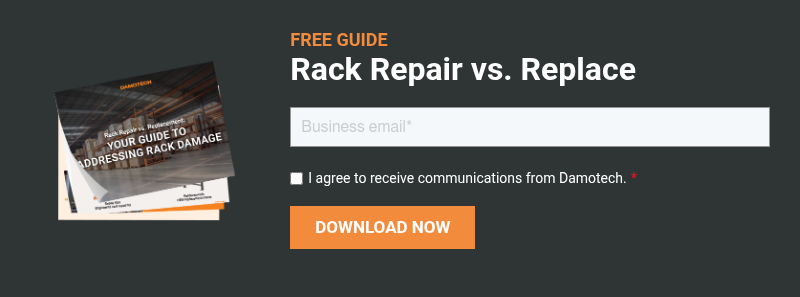When budgets are tight, rack repairs get bumped to “next quarter.” In warehouse safety, “later” can be too late. In modern warehouse operations, safety and uptime go hand in hand; delaying rack repairs threatens both.
If your team sees damaged uprights and bent beams daily, use these facts, math, and talking points to move leadership from delay to decision—now.
10 Reasons Why Postponing Rack Repairs Could Be Your Costliest Mistake
Jump to the reason to get the explanation
- 1. The Cost Hit
- 2. Delay = Bigger Bill
- 3. Worker Safety Risk
- 4. Regulatory Risk
- 5. Culture Takes a Hit
- 6. ROI of Acting Now
- 7. Emergencies Get Expensive
- 8. Reliability = Revenue
- 9. Program Beats Panic
- 10. Peace of Mind
1. A single rack failure can snowball into seven figures
Treating a bent upright as “minor” is a common cognitive bias, but escalation is fast and unforgiving. Direct losses (product write-offs, damaged equipment), indirect losses (downtime, expediting), and injury costs stack quickly.
In 2023, the average cost of a medically consulted work injury was $43,000, and $1.46M per work-related death, before you add property damage or reputational harm.
What leadership needs to hear: a planned five-figure repair budget today protects the business from a multi‑factor loss that can easily reach six or seven figures across claims, lost time, and emergency response. (See Reason 6 for ROI tools)
Bonus proof: A national retailer using Damotech’s programmatic approach re‑channeled $10M/year by preventing damage escalation and unplanned outages, demonstrating that prevention beats recovery.

2. Waiting multiplies scope and cost
Damage spreads: buckled columns deform braces, clips, decking, and anchors. Replacement often forces full bay unloads, dismantling, and long outages, while engineered repair kits minimize pallet racking costs. They are bolted in and typically installed far faster—often with minimal unloading when used with the DAMO EASY LIFT. Smart warehouse operations management recognizes that prevention costs less than crisis recovery.

Why waiting costs more:
- Compromises more components
- Extends aisle isolation
- Triggers premium labor
3. Complacency endangers workers and exposes the company
OSHA’s general industry rule 29 CFR 1910.176(b) requires storage to be “stable and secure against sliding or collapse,” and OSHA’s warehousing guidance flags struck-by and materials-handling hazards as common causes of serious harm. If a known rack hazard injures someone, regulators will ask why it wasn’t corrected.
- Falling objects and collapsing materials are among the top causes of serious warehouse injuries and fatalities.
- Damaged racking directly contributes to these hazards.
- In the U.S. and Canada, employers found negligent in preventing a known hazard can face criminal charges and substantial fines.
4. Postponement can mean regulatory trouble
If an OSHA or provincial inspector finds unsafe racking in your facility:
- United States (OSHA): Maximum OSHA fines (2025) are $16,550 per serious or other-than-serious violation.
- Canada (Ontario OHSA): As of October 2023, the maximum corporate fine increased to $2 million per count; proposals also introduce mandatory minimums for repeat serious-injury cases.
Practical kicker: Inspectors can, and do, order aisles or zones out of service until mitigations are completed, slashing capacity overnight.

5. Delays erode safety culture
When operators see damaged frames sitting for months, they infer safety isn’t prioritized, suppressing near-miss reporting and undermining engagement. Conversely, rapid, visible correction and posted capacities reinforce the norm that hazards get fixed and limits respected.
Research shows that a strong safety culture reduces accidents and improves morale.
ANSI MH16.1 requires load plaques and defines owner responsibilities for use, maintenance, and post-installation inspection. Posting rack capacities is also a compliance expectation across U.S. and Canadian jurisdictions. Download our free Load Capacity eBook now to ensure your racks are safe, compliant, and up to the task.➜
6. ROI favors acting now
Allocating a small line in your warehouse budget for rack maintenance can prevent six-figure losses.
Engineered repair typically restores capacity faster and with less disruption than OEM frame replacement (no hot work; bolt-on install; minimal unload in many scenarios).
- Up to 85% cost savings compared to full replacement.
- Avoided downtime costs: hours saved where “every minute counts.”
- Reduced insurance claims and premiums via proactive risk management.
Quantify it with:
- Damotech Rack Column Repair vs. OEM Replacement ROI Calculator to model the long-term financial impact.
- Repair vs. Replacement Guide comparing installation time, outage, logistics, and warranty considerations.
Typical value drivers: reduced outage hours, avoided expediting/OTR transfers, lower injury exposure, and fewer emergency call-outs. During warehouse budget planning, proactive repair funding should be treated as risk insurance.

7. “Later” doesn’t get cheaper; it gets urgent
The irony is that executives often defer rack repairs to “save money,” but:
- Steel, labor, and freight inflation raise future line-item costs.
- New damage accumulates, increasing the repair scope.
- The result: an emergency at the worst possible time—overtime, premium freight, multi-bay shutdowns.
Delaying maintenance drives up total warehouse costs through downtime, overtime, and damaged goods. Proactive repair with DAMO PRO or DAMO FLEX reduces future risk, ships quickly, and installs fast.
Field reality: the DAMO EASY LIFT lets certified installers lift and stabilize, cut and slide in the repair unit, then re-anchor, often without full bay unloads.
8. Reliability is a revenue promise
Unplanned shutdowns from preventable rack failures ripple through service levels: late deliveries, missed SLAs, lost shelf space, and strained customer trust. OSHA and BLS data show that warehousing has persistent material-handling hazards; reducing unplanned events protects both workers and on-time performance.
9. Real-world: program beats panic
A national multi‑site operator implemented a structured inspection‑repair loop (engineering‑led audits + software + repair kits) and realized $10M/year in compounded savings by preventing escalation, standardizing fixes, and shortening outage windows.
That same approach is repeatable with DAMO CARE and the Damotech Platform (digital findings, LARC/labels, photos, and corrective actions). Watch the demo now to see how the Damotech Platform modernizes rack inspection and asset management.➜
10. Peace of mind is priceless—and measurable
Fast correction of known damage helps people (operators feel protected; safety leaders sleep better) and performance (higher uptime, fewer claims, cleaner audits).
Build your case on accepted thresholds and standards:
- Out of plumb: ANSI MH16.1 uses 1/240 top-to-bottom for loaded uprights (≈1/2" per 10ˈ).
- Owner responsibilities include maintenance, inspection cadence, repair/replacement of damaged components, and load plaques.
- Canadian guidance (CSST/WorkSafe-aligned) reinforces inspection frequency, anchoring, and guarding.
Making the pitch to leadership (copy-paste ready)
- Lead with risk: OSHA 1910.176(b) requires secure storage; violations now up to $16,550 (U.S.).
- Show the math: Use the ROI Calculator and the Repair vs. Replacement Guide to compare proactive repair outage hours and total cost.
- Offer a turnkey plan: Third-party engineering inspection + prioritized repair schedule + digital tracking + recurring safety program.
- Close on ROI and risk avoidance: NSC estimates injury costs at an average of $43,000 per case; prevention protects people and P&L.
Final takeaway for decision makers: Postponing rack repair isn’t saving money; it’s concentrating risk and compounding cost. Acting now is the safer and smarter business decision.
References
https://rcpsystem.com/news/rack-collapse-a-serious-problem-with-a-smart-solution
https://www.brightlysoftware.com/learning-center/ROI-preventive-maintenance
https://mathewsdinsdale.com/ontario-hikes-corporate-ohsa-penalties-to-highest-in-canada/
Frequently Asked Questions on Rack Repair and Safety
How often should pallet racks be inspected for damage?

What is considered “out of plumb,” and why does it matter?

Can we weld or straighten a damaged upright instead of repairing it?

What happens if we change beam heights or rack configurations?

Is rack damage always visible?

What’s the difference between rack repair and replacement?

Are load-capacity plaques legally required?

Can damaged racks affect our insurance coverage?

What standards govern rack safety in North America?

- ANSI MH16.1 (2023) — Design, testing & utilization of industrial steel storage racks
- OSHA 29 CFR 1910.176(b)—Stable storage & material handling
- CSA A344:24—User guide for steel storage racks (Canada)
- WorkSafeBC & CCOHS—Provincial/Canadian safety directives
How can we make rack safety a continuous process?

Implement the Rack Safety Flywheel:
1. Engineering inspection
2. Digital reporting
3. Repair coordination
4. Preventive guarding
5. Annual follow-up.
This integrated loop, offered through DAMO CARE and the Damotech Platform, keeps rack conditions visible, measurable, and compliant year-round.










